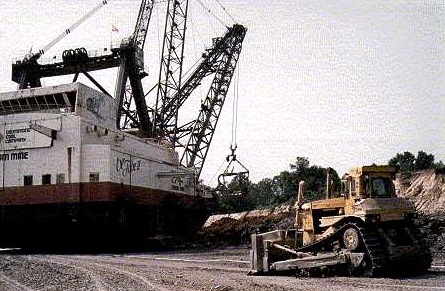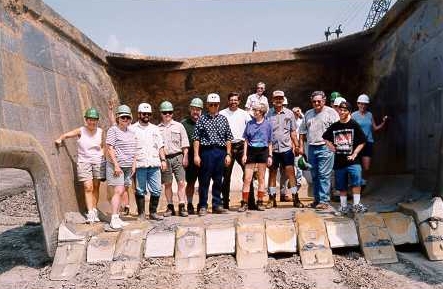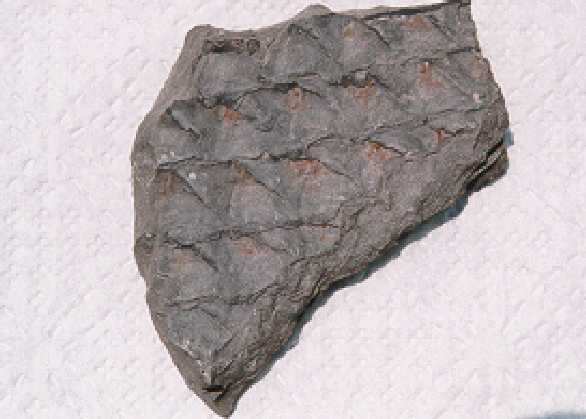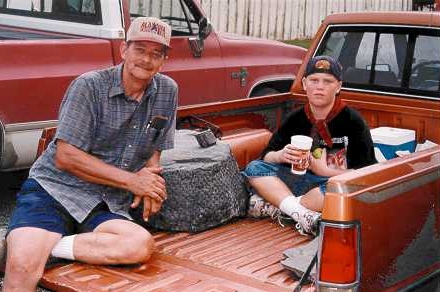|
--Edited by Vicki Lais
 |
The dragline. The 180 ton
bucket is hanging in the middle
of the photo. |
 |
| Climbing into the dragline. |
|
 The machine uses a 180 ton metal bucket to drag soil and rock forward The machine uses a 180 ton metal bucket to drag soil and rock forward
for lifting, and then rotates to dump the material on an area that has
already been mined. The machine is so large and so specialized that,
according to Mr. Hendon, it cost $36 million when it was brand new. Not
only were we allowed to view the dragline from close up, but we were
also able to go inside and see how it works. The movements of the
bucket can be efficiently operated by one person, but three other
workers are usually present to keep the machinery functioning and
oiled. The complex manipulations of the dragline depend on 16 giant
motors of over 100 horsepower each, one of which we saw winding and
unwinding the huge cables connected to the bucket. Other motors rotate
the whole assembly and move it. We all visited the operator control
room, as well as a second empty control room. Inside the machine, the
noise was loud enough to necessitate the use of earplugs. After
visiting the dragline, Mr. Hendon took us all to a second bucket no
longer in use, where I took the group photograph shown here.
|
After this part of the tour, Mr. Hendon
then led us all to an area
where we could search for plant fossils. Like many other sites in
Walker and Jefferson Counties, plant fossils from the Carboniferous
period are present in abundance at Cedrum. Mr. Hendon first pointed
out to us a couple of fossil stumps of arborescent lycopods, one of
which was partly removed by BPS members James Lowery and Danny Brooks.
The piece Danny Brooks showed me weighed about 100 lbs and showed
characteristic
scars of a likely Lepidodendron. Interestingly, the cross section of
the
stump showed scars as well, but I am not sure exactly what these
represent.
Danny has very graciously donated the specimen to the Southern
Environmental
Center, who plan a special display.
|
| |
Other items found at the site included numerous
medullary casts of the
familiar Calamites, a member of the horsetail phylum. The largest piece
shown to me was about 8 inches long and about 4 inches in diameter.
All of the pieces I saw, including a small one I found myself, showed
well-defined linear furrows and ridges aligned parallel to the
direction
of the stem. The raised furrows represent vascular bundles of the
plant, and
are basically inverse impressions of the life features. The narrower
ridges,
also inverse, are known as medullary rays. The casts represent the
inner
pith cavities of the plant, which were either hollow or had only soft
tissue that quickly decayed. When these cavities filled with mud, the
mud solidified and preserved an impression of the

inside of the plant.
Some specimens looked broken at a node, a place where leaves and
branches could emanate from the plant. The node is a horizontal ridge,
and the small specimen I show here has two nodes. Sometimes a node may
be preserved
in cross-section. On splitting one rock, I found a large node
impression
with thin radiating structures, probably leaves. However, none of the
inner structure of the node was preserved in this piece. |
| |
 One of the most interesting fossils I noticed at this site was a One of the most interesting fossils I noticed at this site was a
modest-sized bark impression of Lepidophloios, a subgenus of the
Lepidodendra. The leaf scars of Lepidophloios are very much like those
of a normal Lepidodendron stem, only the scars are elongated
horizontally, rather than vertically. Although I have read that fossils
of Lepidophloios are the most commonly found plant fossil in Alabama,
it was the first time I had seen a definitive example. It was easily
distinguished from the better known Lepidodendron.Also found at
the site were various seed fern impressions, the most familiar ones I
noticed being Alethopteris and Neuropteris. The latter were often found
as disconnected and relatively large pinnules. One BPS attendee showed
me a nice slab of intact Alethopteris ferns. He was so happy to have
the slab, and it was so fragile, that he said he was going to carry it
home on his lap! Related to these ferns, I believe I found what appear
to be two branches of a likely tree-sized seed fern plant. The branches
have a brownish color with some carbonized plant material remaining,
and bear no resemblance to the branches of Calamites or the arborescent
lycopods. No fern impressions are attached to these branches, but I
have seen other similar specimens having attached ferns. |
| |
|
 Easily the most spectacular find of this trip was a 300-400 pound Easily the most spectacular find of this trip was a 300-400 pound
arborescent lycopod stump found by James Foshee. The specimen is about
1 foot thick and tapers from a diameter of about 2 feet to 3 feet from
top to bottom. All around the rim, the stump is covered with beautiful,
well-defined leaf scars, the appearance of which suggests to me that
the specimen is of the genus Lepidodendron. From its curved shape, it
looks like a part of the lower base of a much larger trunk. The
preservation is as good as any I have seen of these trunks in museums.
A happy day for James!
|
In summary, this was a really great field
trip for the BPS. If it had not
been so hot, it might have been even better!
|



 The machine uses a 180 ton metal bucket to drag soil and rock forward
The machine uses a 180 ton metal bucket to drag soil and rock forward
 One of the most interesting fossils I noticed at this site was a
One of the most interesting fossils I noticed at this site was a Easily the most spectacular find of this trip was a 300-400 pound
Easily the most spectacular find of this trip was a 300-400 pound